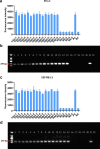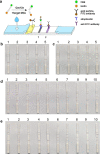CRISPR/Cas12a combined with RPA for detection of T. gondii in mouse whole blood
- PMID: 37518013
- PMCID: PMC10387196
- DOI: 10.1186/s13071-023-05868-0
CRISPR/Cas12a combined with RPA for detection of T. gondii in mouse whole blood
Abstract
Background: Toxoplasma gondii is an opportunistic protozoan that is ubiquitous in humans and animals. It can invade any human organ and cause severe diseases, including toxoplasma ophthalmopathy, meningoencephalitis, and liver necrosis. Porcine toxoplasmosis is prevalent in China. CRISPR (Clustered Regularly Interspaced Short Palindromic Repeats) and Cas (CRISPR-Associated Protein) systems are widely used for gene editing and pathogen detection. CRISPR-based diagnostics are molecular assays that have been developed to detect parasites with high sensitivity and specificity.
Methods: This study aimed to establish a combined CRISPR/Cas12a and RPA rapid detection method for T. gondii by targeting the B1 gene and 529 bp repeat element (529 RE). The detection results could be visualized by the fluorescence or lateral flow strips (LFS). The sensitivity and specificity of the method were evaluated, and T. gondii-infected mouse blood was used for detection.
Results: The results indicated that the established method for T. gondii detection was satisfactory, with a detection limit of 1.5 cp/μl for the two loci. Moreover, the B1 gene could detect 1 tachyzoite per reaction, and the 529 RE could detect 0.1 tachyzoite per reaction, consistently with the highly sensitive nested polymerase chain reaction (PCR) results. The method was suitable for strains, including RH, and did not cross-react with other protozoa DNA with similar habits. The T. gondii-infected mouse blood samples were all positive for T. gondii at 1, 3, and 5 days post infection (dpi).
Conclusions: This study established a rapid, sensitive, and time-saving DNA detection method for T. gondii that has the potential to be an alternative tool for T. gondii detection in the field.
Keywords: CRISPR/Cas12a; LFS; Mouse blood; Nucleic acid testing; T. gondii.
© 2023. The Author(s).
Conflict of interest statement
The authors declare that they have no competing interests.
Figures





Similar articles
-
RPA-CRISPR/Cas12a-LFA combined with a digital visualization instrument to detect Toxoplasma gondii in stray dogs and cats in Zhejiang province, China.Microbiol Spectr. 2024 Jul 2;12(7):e0399823. doi: 10.1128/spectrum.03998-23. Epub 2024 May 29. Microbiol Spectr. 2024. PMID: 38809001 Free PMC article.
-
RPA/CRISPR/Cas12a-Based On-Site and Rapid Nucleic Acid Detection of Toxoplasma gondii in the Environment.ACS Synth Biol. 2022 May 20;11(5):1772-1781. doi: 10.1021/acssynbio.1c00620. Epub 2022 Apr 26. ACS Synth Biol. 2022. PMID: 35471824
-
A novel single-tube LAMP-CRISPR/Cas12b method for rapid and visual detection of zoonotic Toxoplasma gondii in the environment.Infect Dis Poverty. 2024 Dec 10;13(1):94. doi: 10.1186/s40249-024-01266-5. Infect Dis Poverty. 2024. PMID: 39654027 Free PMC article.
-
[Progress of researches on toxoplasmosis vaccines based on the CRISPR/Cas9 technology].Zhongguo Xue Xi Chong Bing Fang Zhi Za Zhi. 2024 Sep 20;36(5):542-547. doi: 10.16250/j.32.1374.2024026. Zhongguo Xue Xi Chong Bing Fang Zhi Za Zhi. 2024. PMID: 39623998 Review. Chinese.
-
[Problems and limitations of conventional and innovative methods for the diagnosis of Toxoplasmosis in humans and animals].Parassitologia. 2004 Jun;46(1-2):177-81. Parassitologia. 2004. PMID: 15305712 Review. Italian.
Cited by
-
Detection of Parasites in the Field: The Ever-Innovating CRISPR/Cas12a.Biosensors (Basel). 2024 Mar 14;14(3):145. doi: 10.3390/bios14030145. Biosensors (Basel). 2024. PMID: 38534252 Free PMC article. Review.
-
The role of microRNA-142a in Toxoplasma gondii infection-induced downregulation of Foxp3: implications for adverse pregnancy outcomes.BMC Infect Dis. 2024 May 13;24(1):490. doi: 10.1186/s12879-024-09375-0. BMC Infect Dis. 2024. PMID: 38741041 Free PMC article.
References
MeSH terms
Substances
Grants and funding
LinkOut - more resources
Full Text Sources
Medical
Research Materials
Miscellaneous

